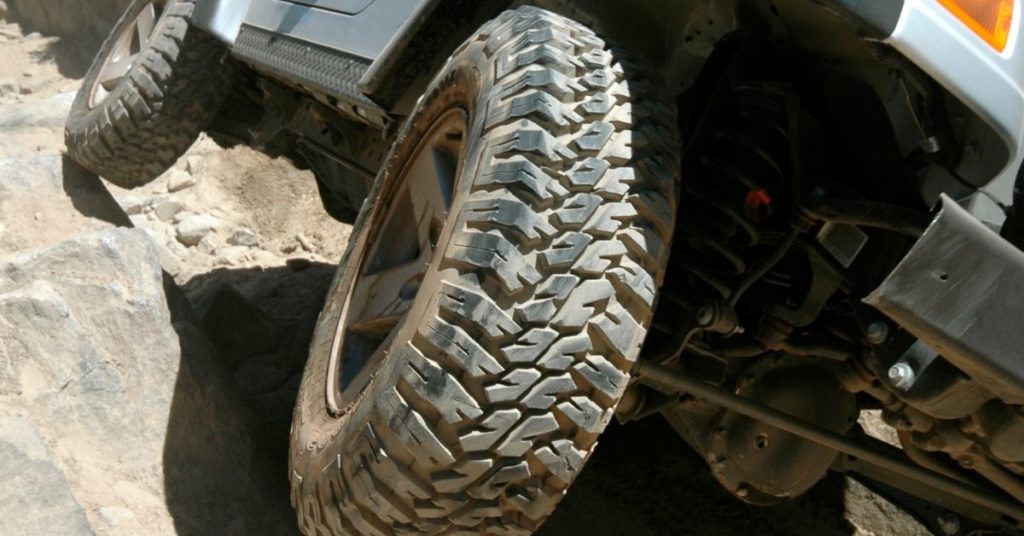All-terrain tires are an excellent choice for those who want to use their four-wheel drive as a regular vehicle. They can help you gain access to all kinds of tracks without inhibiting your ability to drive safely and comfortably on paved roads.
On average, all-terrain tires last around 40,000 miles.
What Are All-Terrain Tires?
All-terrain tires are tires that are designed to be more capable for harsher terrains like mud, dirt, and sand. They are built to be stronger with reinforced sidewalls to protect the tire from damage by rocks, ruts, and sticks as you drive off-road.
These tires also have deeper and more aggressive tread patterns that extend over the shoulder of the tires for maximum grip.
They are designed for 60% on-road and 40% off-road driving conditions which make them more realistic for those looking to use their four-wheel-drive as a more casual vehicle.
This means that you will be able to drive practically anywhere on and off-road making the world your oyster in terms of four-wheel driving.
Do All-Terrain Tires Wear Faster?
The answer to this question depends on what style of the tire you are comparing it to.
When comparing all-terrain tires to highway tires they will typically wear faster. This is due to a variety of reasons including:
- They are used in more extreme driving conditions. Driving uphill, over ruts, and through inconsistent terrains will wear tires more quickly.
- They are not purely designed for highways. In all realism, your four-wheel drive will be driven mostly on highways. However, this style of tire is only designed to be on highways for 60%. Of course, they will wear quicker than tires only designed for highway driving!
- The tread pattern of all-terrain tires will wear quicker on sealed roads as they are designed for muddy and dirt tracks, not solid roads.
- All-terrain vehicles use softer rubber compounds. In off-road environments, this will give you extra grip and traction helping you conquer any track and obstacle. However, the highways you will be driving most on are hard and will cause greater wear over time.
It’s worthwhile to note that all-terrain tires will wear better than mud tires. This is because they are designed for some highway use. While mud tires are designed purely for off-road purposes so will wear much quicker especially when used repeatedly on sealed roads.
Are All Terrain Tires Durable?

The answer to that question depends on what terrain you drive on most. Different terrains and conditions will impact your tires in different ways. Furthermore, there is a dramatic difference between the types of wear your tires will experience on sealed and unsealed roads.
All-terrain tires are extremely durable in off-road conditions. They are built with reinforced sidewalls that are resistant to sharp rocks and sticks from piercing them. All-terrain tires are also shaped so that debris will bounce off the sides and not get caught in the tread.
These factors are combined to ensure that the tire does not damage easily and is highly durable in harsh driving conditions.
All-terrain tires are less durable on sealed roads. This style of tire may wear more quickly than regular highway tires. This may cause you to need more frequent replacements if you use your vehicle as a daily vehicle.
Durability is an important consideration because it will determine how frequently you replace the tires. Using highway tires off-road will lead to much more frequent replacement as they are not resistant to damage. Using off-road tires on sealed roads will lead to more frequent replacements however, these will generally be less frequent than blowouts off-road.
When should I Replace My All-Terrain Tires?
How frequently you replace your all-terrain tires depends on many factors.
- Manufacturer’s recommendations are a great place to start. Depending on the quality, composition, and construction of your tire the lifespan is generally around 30 000- 40 000 miles of use.
- You can also tell by the depth and definition of your tread. If you insert a penny in the grove of the tread you should not be able to see the tip of Lincoln’s hairline. If you can see his whole hairline then a replacement is overdue. There may also be indicators on the tires themselves, these are bumps that you can use to feel wear.
- Rubber degrades over time so even if you do not use your vehicle often and the tread is still fine you should replace it at least once every decade. This will save you from getting stuck in a sticky situation in the middle of the trail.
- If you notice you are constantly out of grip on tracks you never had an issue this is another clear indication. As your tread wears you will gradually lose traction and begin to slip and slide on tracks you used to have no issues with.
How To Improve the Lifespan of Your All-Terrain Tire
If you are worried about getting maximum longevity and value for money from your all-terrain tires there are a variety of simple ways to increase the lifespan of tires. These simple tips and tricks can help reduce wear and tear on your tires allowing you to enjoy your tires for longer.
- Rotate your tires regularly. Removing the tires and rotating them to different positions on the car (e.g., front left, back right) will ensure all tires wear evenly. This can improve the quality and endurance of your tires. Rotating your tires every service of your car can dramatically increase the lifespan of your all-terrain tires.
- Try to drive smoothly. Sudden acceleration and braking will increase the wear on your tires. This will lead to more frequent replacements and more money down the drain.
- Avoid driving uphill as much as possible. While you shouldn’t be deterred from uphill tracks, the more uphill driving you do the quicker the wear on your tires will be. This is because there is more resistance that your car needs to combat and it can often result in deep ruts and rock steps that will also wear down your tires.
Conclusion
All-terrain tires are an excellent choice for those looking to take full advantage of their four-wheel drives. They are designed to give you access to practically anywhere without impacting your ability to use your vehicle as a daily run-about.
Generally, they will wear quicker than highway tires due to the conditions they are driven in and their design. However, there are many simple ways you can extend their lifespan to take full advantage of your vehicle and maintain your value for money.
- Tips and tricks For Setting Up Camp Like a Pro - September 11, 2023
- The Best Multi-Tools for Overlanding Adventures - August 25, 2023
- Off-Road Navigation Tips for Overlanders - August 13, 2023


